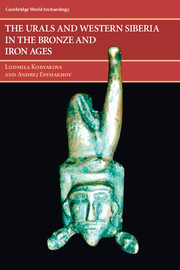Introduction
Published online by Cambridge University Press: 03 February 2010
Summary
The Ural area can be defined in terms of its geographic location as a natural boundary between Europe and Asia. It is characterized by great landscape and environmental diversity: steppe, forest-steppe, forests, and mountains. In late prehistory, these areas were occupied by societies on different social and economic levels (nomadic, half-nomadic, settled pastoralists, specialist metallurgists), and different ethnic attributions (supposedly proto-Iranian and proto-Finno-Ugrian speakers). This area offers an interesting opportunity to examine cultural behavior at an important crossroads, where the influences of the East, the West, the North, and the South meet. This interaction resulted in a great variety of cultural traditions that had either European or Asiatic origins. Therefore, it is quite difficult to separate the prehistory of the Urals and Western Siberia area from that of the rest Eurasia.
This book will focus on the problems of the archaeology of the Bronze and Iron Ages, which are characterized by dramatic changes occurring all over Eurasia in later prehistory.
Historical evidence about the Uralian population is extremely sparse and vague. It goes back to Herodotus, later to the Arabian travellers and merchants. In the tenth century ce, they knew the northern lands called “Ugra,” but Russians from the city of Novgorod, who first crossed the Urals in the eleventh century and met the Finno-Ugrian population, undertook the first systematic exploration of this territory. Russians colonized the southern Urals and most of Siberia from the fifteenth century onward.
- Type
- Chapter
- Information
- Publisher: Cambridge University PressPrint publication year: 2007



